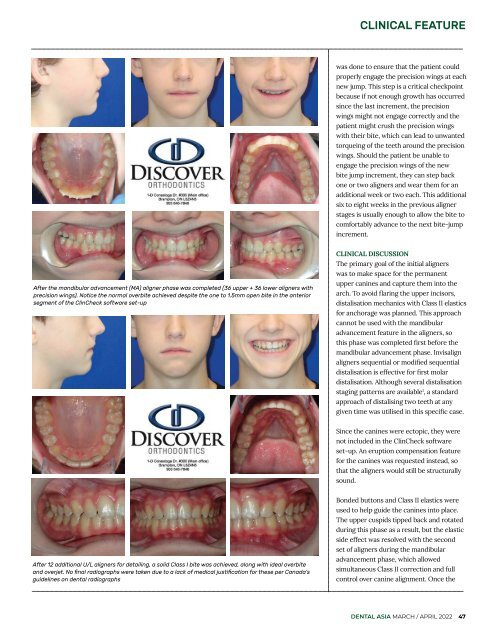Dental Asia March/April 2022
For more than two decades, Dental Asia is the premium journal in linking dental innovators and manufacturers to its rightful audience. We devote ourselves in showcasing the latest dental technology and share evidence-based clinical philosophies to serve as an educational platform to dental professionals. Our combined portfolio of print and digital media also allows us to reach a wider market and secure our position as the leading dental media in the Asia Pacific region while facilitating global interactions among our readers.
For more than two decades, Dental Asia is the premium journal in linking dental innovators and manufacturers to its rightful audience. We devote ourselves in showcasing the latest dental technology and share evidence-based clinical philosophies to serve as an educational platform to dental professionals. Our combined portfolio of print and digital media also allows us to reach a wider market and secure our position as the leading dental media in the Asia Pacific region while facilitating global interactions among our readers.
- No tags were found...
Create successful ePaper yourself
Turn your PDF publications into a flip-book with our unique Google optimized e-Paper software.
CLINICAL FEATURE<br />
was done to ensure that the patient could<br />
properly engage the precision wings at each<br />
new jump. This step is a critical checkpoint<br />
because if not enough growth has occurred<br />
since the last increment, the precision<br />
wings might not engage correctly and the<br />
patient might crush the precision wings<br />
with their bite, which can lead to unwanted<br />
torqueing of the teeth around the precision<br />
wings. Should the patient be unable to<br />
engage the precision wings of the new<br />
bite jump increment, they can step back<br />
one or two aligners and wear them for an<br />
additional week or two each. This additional<br />
six to eight weeks in the previous aligner<br />
stages is usually enough to allow the bite to<br />
comfortably advance to the next bite-jump<br />
increment.<br />
After the mandibular advancement (MA) aligner phase was completed (36 upper + 36 lower aligners with<br />
precision wings). Notice the normal overbite achieved despite the one to 1.5mm open bite in the anterior<br />
segment of the ClinCheck software set-up<br />
CLINICAL DISCUSSION<br />
The primary goal of the initial aligners<br />
was to make space for the permanent<br />
upper canines and capture them into the<br />
arch. To avoid flaring the upper incisors,<br />
distalisation mechanics with Class II elastics<br />
for anchorage was planned. This approach<br />
cannot be used with the mandibular<br />
advancement feature in the aligners, so<br />
this phase was completed first before the<br />
mandibular advancement phase. Invisalign<br />
aligners sequential or modified sequential<br />
distalisation is effective for first molar<br />
distalisation. Although several distalisation<br />
staging patterns are available 1 , a standard<br />
approach of distalising two teeth at any<br />
given time was utilised in this specific case.<br />
Since the canines were ectopic, they were<br />
not included in the ClinCheck software<br />
set-up. An eruption compensation feature<br />
for the canines was requested instead, so<br />
that the aligners would still be structurally<br />
sound.<br />
After 12 additional U/L aligners for detailing, a solid Class I bite was achieved, along with ideal overbite<br />
and overjet. No final radiographs were taken due to a lack of medical justification for these per Canada’s<br />
guidelines on dental radiographs<br />
Bonded buttons and Class II elastics were<br />
used to help guide the canines into place.<br />
The upper cuspids tipped back and rotated<br />
during this phase as a result, but the elastic<br />
side effect was resolved with the second<br />
set of aligners during the mandibular<br />
advancement phase, which allowed<br />
simultaneous Class II correction and full<br />
control over canine alignment. Once the<br />
DENTAL ASIA MARCH / APRIL <strong>2022</strong> 47


















